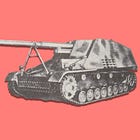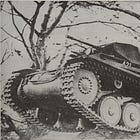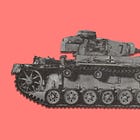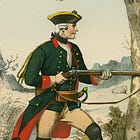Published under the deceptively simple title of “Tanks,” the first feature article in the first issue of the Armored Forces Newsletter [Nachrichtenblatt der Panzertruppen] discusses three topics: the functional characteristics of armored formations, the employment of tanks, and the Tiger tank. This post provides a translation of the second segment of the piece.
II. The Employment of Tanks
After-action reports stress the following points:
A. People other than tank specialists [Nicht-Panzerfachleuten] repeatedly make the following mistakes:
1. Wasteful Employment: Use of single tanks as bunkers in forward positions and use armored weapons carriers for raiding parties [Stosstrupps] and reconnaissance patrols
2. Improper Employment: Hurried employment of tanks, without scouting and preparations for the attack. Employment over ground covered with tank obstacles, whether natural or man-made. Employment of a tank company as an independent unit without the assistance of infantry.
3. Absence of Cooperation with Other Arms: Employment against a well-prepared enemy without the support of artillery and infantry. Rushed employment, without preparations for cooperation with other weapons and without listening to the commander of the tank unit.
4. Absence of Opportunities for Maintenance: Failure to understand the need to supply and maintain tanks leads to breakdowns.
B. Basic rules that have proven themselves in the course of tank attacks
1. In addition to clear and firm leadership, the foundation of success lies in the maturity that tank crews acquire in training and combat.
2. Continuous cultivation [Erziehung] of the mental toughness [Härte] of leaders and units, as well as continual instruction in lessons learned on the battlefield.
3. Thorough preparation of each attack, to include detailed instructions to, and discussions with, all participants. Assurance of support from all arms.
4. Exploitation of all results of scouting and reconnaissance, to include those of units in sectors other than the one where the tank attack will take place.
5. Frequent changes of attack methods. Flexible direction in the attack. Deception and confusion of the enemy. Surprise attacks. Frontal feints [Scheinangriffe] combined with massive attacks in the flank and rear of the enemy. Employment of smoke.
6. Attacks against enemy tanks and anti-tank defenses that make cunning use of terrain in the manner of a hunter.
7. Concentrated employment of [all tanks in] each tank unit, especially when it is weak in tanks. No employment of individual tanks. Employment of less than a company of tanks always leads to heavy losses, which are disproportionate to the results achieved.
8. For the most part, tanks attack out of the darkness into the day, not the other way around. Nonetheless, they attack with the sun behind them, not in front of them.
9. If forced to go over to the defensive, tanks will always be employed aggressively. They will frequently change the places where they hold themselves in readiness [Bereitstellungen].
To be continued …
Source: A typescript of the first issue of the Nachrichtenblatt der Panzertruppen can be found on the website of the German Federal Archive. Printed copies of subsequent issues are available at Sturmpanzer.com.
For Further Reading:










With a name like "The Employment of Tanks", let's speculate on the obverse.
III. The Unemployment of Tanks
1. In the fortunate circumstance that there is no war on, the tank is a large and relatively wasteful tractor with a lot of weight in armor and guns.
2. We therefore recommend that tanks be relegated to maintenance, training, and readiness duties in these circumstances.
3. Peacetimes should be taken as an opportunity to standardize and pare the fleet in order to maintain a ready stock of spare parts, mothballed tanks, and reorganize production.
"Tanks attack out of the darkness into the day, not the other way around. Nonetheless, they attack with the sun behind them, not in front of them."
Am I missing something?
"Attack in the early morning (if going east) or late evening (if west). Nonetheless, attack in the late evening (if going east) or early morning (if west)."